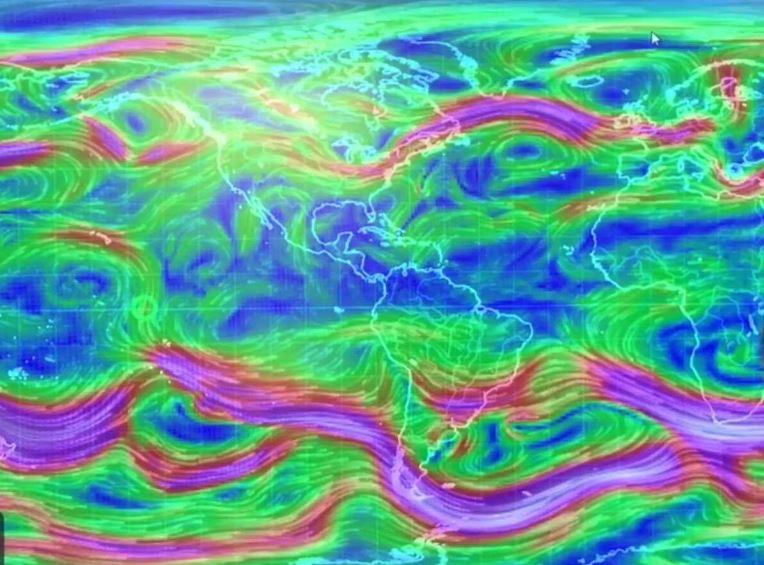'Global climate emergency' over jet stream crossing equator dismissed by scientists
'There isn’t a wall at the equator separating the two hemispheres, and air is free to flow from one side to the other'

Two bloggers have made a stunning claim that has spread like wildfire on the Internet: They say the Northern Hemisphere jet stream, the high-altitude river of winds that separates cold air from warm air, has done something new and outrageous. They say it has crossed the equator, joining the jet stream in the Southern Hemisphere. One said this signifies that the jet stream is ‘wrecked‘, the other said it means we have a “global climate emergency".
But these shrill claims have no validity — air flow between the hemispheres occurs routinely. The claims are unsupported and unscientific, and they demonstrate the danger of wild assertions made by non-experts reaching and misleading the masses.
The two bloggers who have perpetuated this misinformation are Robert Scribbler, who describes himself as ”a progressive novelist, non-fiction writer and emerging threats expert,” and Paul Beckwith, who is working on a PhD with “a focus on abrupt climate system change” at the University of Ottawa.
Scribbler says the cross-equator flow is a manifestation of man-made global warming, supported by the hypothesis that disproportionate heating of the Arctic is destabilizing the jet stream. “The Hemispherical Jet Streams have moved out of the Middle Latitudes more and more,” he writes. “More and more it has invaded regions both within the Polar zone and within the Tropics. Now, it appears that the old dividing lines are so weak that flows of upper level air between Hemispheres can be exchanged.”
He concludes that this “violation of dividing lines” is “a kind of weather weirding that we are not at all really prepared to deal with".
Beckwith writes that the jet stream behaviour is “unprecedented” and represents “climate system mayhem”: “Our climate system behaviour continues to behave in new and scary ways that we have never anticipated, or seen before. . . . We must declare a global climate emergency.”
I reached out to several atmospheric scientists, who have graduate degrees and are trusted sources in the profession, for their reaction to these claims. Without exception, they said air flow between the hemispheres is not at all uncommon.
“This is total nonsense,” said Cliff Mass, a professor of meteorology at the University of Washington. “Flow often crosses the equator.”
Mass added that the cross-equator flow identified by Scribbler and Beckwith is not between mid-latitude jet streams, as claimed. “The analysis is making mistakes that even one of my junior undergrads would not make,” Mass said.
Ryan Maue, a senior meteorologist with a doctoral degree who works at WeatherBell Analytics, agreed with Mass that the cross-equator flow is totally normal and not evidence of a joint hemispheric jet stream. “Cross-equatorial flow at both upper and lower levels is part of the seasonal transition of the Western Pacific monsoon through boreal summer,” he said.
“Sometimes the flows connect up with each other and make it look like a larger flow structure is causing the jet stream to flow from one hemisphere to the other, but it’s in no way unprecedented,” Roy Spencer, a professor of atmospheric science at University of Alabama-Huntsville, explained on his blog.
To be clear, the hypothesis that global warming is destabilizing the polar jet stream is a legitimate idea that has been published in peer-reviewed journals, though it remains controversial. But even the scientist who developed the hypothesis, Jennifer Francis, a professor of meteorology at Rutgers University, suggested it had been misapplied by Scribbler and Beckwith. “I’d say cross-equator flow cannot be unprecedented, maybe not even all that unusual,” she said.
Sam Lillo, who is working on his PhD in meteorology at the University of Oklahoma, said the cross-equator flow evolved from twin areas of high pressure on either side of the equator while a parade of atmospheric waves in the Southern Hemisphere had pushed the subtropical (which is distinct from the mid-latitude or polar jet stream that Scribbler and Beckwith are discussing) jet stream northward, allowing the link to occur. “None of this is unusual,” he said. “There isn’t a wall at the equator separating the two hemispheres, and air is free to flow from one side to the other.”
Scribbler had cited a tweet from Lillo to support his argument of a strengthened equator-to-pole connection, but Lillo countered that the tweet referred to some unusual behavior of a phenomenon known as the QBO or Quasi-Biennial Oscillation, which is “a separate story” from the cross-equator flow. The QBO, he said, is an oscillation in equatorial stratospheric winds, which has been “out of phase.” He chalked up the weird QBO behavior to natural variability “even though I’m an advocate for identifying connections to human-caused climate change".
Unfortunately, the thoroughly specious claims of Scribbler and Beckwith have gone viral, getting picked up Raw Story, Reddit and Inhabitat.
Such information viewed through the lens of a non-specialist may come across as both credible and alarming but damages the reputation of the science when ultimately shown to be flawed.
“This fear-mongering helps no one,” Maue said.
Examples like this demonstrate the pitfalls of extraordinary claims posted on blogs and the importance of consuming science that has been vetted and peer-reviewed.
Copyright Washington Post
Join our commenting forum
Join thought-provoking conversations, follow other Independent readers and see their replies
Comments
Bookmark popover
Removed from bookmarks